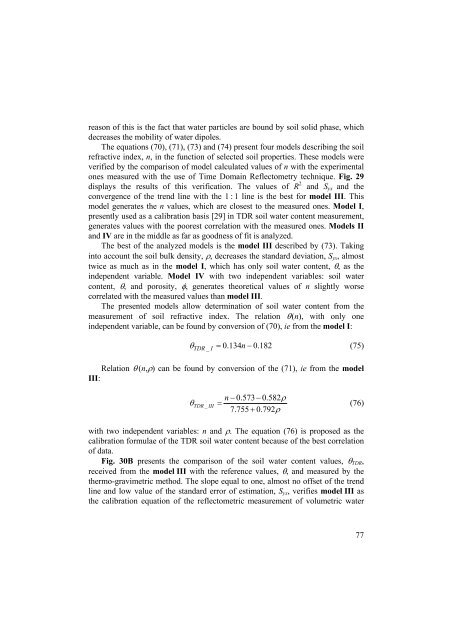ekS - Instytut Agrofizyki im. Bohdana DobrzaÅskiego PAN w Lublinie ...
ekS - Instytut Agrofizyki im. Bohdana DobrzaÅskiego PAN w Lublinie ...
ekS - Instytut Agrofizyki im. Bohdana DobrzaÅskiego PAN w Lublinie ...
Create successful ePaper yourself
Turn your PDF publications into a flip-book with our unique Google optimized e-Paper software.
eason of this is the fact that water particles are bound by soil solid phase, which<br />
decreases the mobility of water dipoles.<br />
The equations (70), (71), (73) and (74) present four models describing the soil<br />
refractive index, n, in the function of selected soil properties. These models were<br />
verified by the comparison of model calculated values of n with the exper<strong>im</strong>ental<br />
ones measured with the use of T<strong>im</strong>e Domain Reflectometry technique. Fig. 29<br />
displays the results of this verification. The values of R 2 and S yx and the<br />
convergence of the trend line with the 1 : 1 line is the best for model III. This<br />
model generates the n values, which are closest to the measured ones. Model I,<br />
presently used as a calibration basis [29] in TDR soil water content measurement,<br />
generates values with the poorest correlation with the measured ones. Models II<br />
and IV are in the middle as far as goodness of fit is analyzed.<br />
The best of the analyzed models is the model III described by (73). Taking<br />
into account the soil bulk density, ρ, decreases the standard deviation, S yx , almost<br />
twice as much as in the model I, which has only soil water content, θ, as the<br />
independent variable. Model IV with two independent variables: soil water<br />
content, θ, and porosity, φ, generates theoretical values of n slightly worse<br />
correlated with the measured values than model III.<br />
The presented models allow determination of soil water content from the<br />
measurement of soil refractive index. The relation θ(n), with only one<br />
independent variable, can be found by conversion of (70), ie from the model I:<br />
θ = 0.134n<br />
− 0.182<br />
(75)<br />
TDR _ I<br />
Relation θ (n,ρ) can be found by conversion of the (71), ie from the model<br />
III:<br />
0.573 − 0.582ρ<br />
θ _ = n −<br />
TDR III<br />
(76)<br />
7.755 + 0.792ρ<br />
with two independent variables: n and ρ. The equation (76) is proposed as the<br />
calibration formulae of the TDR soil water content because of the best correlation<br />
of data.<br />
Fig. 30B presents the comparison of the soil water content values, θ TDR ,<br />
received from the model III with the reference values, θ, and measured by the<br />
thermo-grav<strong>im</strong>etric method. The slope equal to one, almost no offset of the trend<br />
line and low value of the standard error of est<strong>im</strong>ation, S yx , verifies model III as<br />
the calibration equation of the reflectometric measurement of volumetric water<br />
77
















